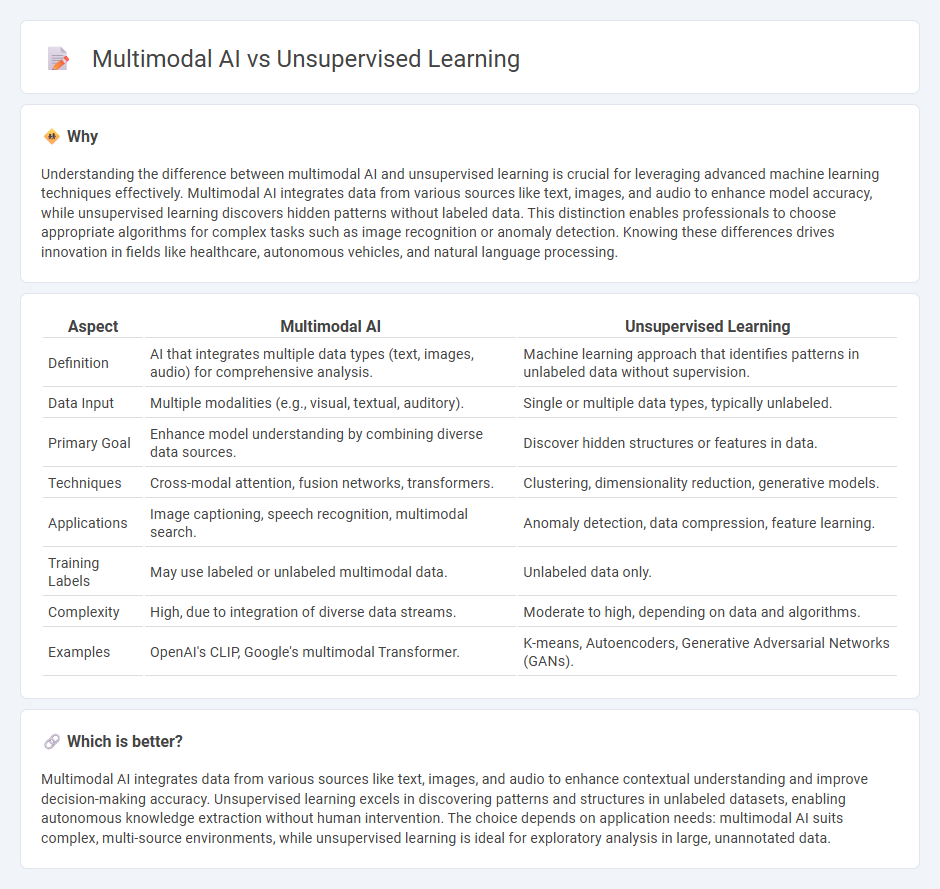
Multimodal AI integrates data from diverse sources such as text, images, and audio to enhance understanding and decision-making capabilities beyond singular data types. Unsupervised learning focuses on discovering patterns and structures in unlabeled data, enabling models to infer insights without explicit guidance. Explore deeper to understand how these advanced artificial intelligence techniques transform technology and data analysis.
Why it is important
Understanding the difference between multimodal AI and unsupervised learning is crucial for leveraging advanced machine learning techniques effectively. Multimodal AI integrates data from various sources like text, images, and audio to enhance model accuracy, while unsupervised learning discovers hidden patterns without labeled data. This distinction enables professionals to choose appropriate algorithms for complex tasks such as image recognition or anomaly detection. Knowing these differences drives innovation in fields like healthcare, autonomous vehicles, and natural language processing.
Comparison Table
| Aspect | Multimodal AI | Unsupervised Learning |
|---|---|---|
| Definition | AI that integrates multiple data types (text, images, audio) for comprehensive analysis. | Machine learning approach that identifies patterns in unlabeled data without supervision. |
| Data Input | Multiple modalities (e.g., visual, textual, auditory). | Single or multiple data types, typically unlabeled. |
| Primary Goal | Enhance model understanding by combining diverse data sources. | Discover hidden structures or features in data. |
| Techniques | Cross-modal attention, fusion networks, transformers. | Clustering, dimensionality reduction, generative models. |
| Applications | Image captioning, speech recognition, multimodal search. | Anomaly detection, data compression, feature learning. |
| Training Labels | May use labeled or unlabeled multimodal data. | Unlabeled data only. |
| Complexity | High, due to integration of diverse data streams. | Moderate to high, depending on data and algorithms. |
| Examples | OpenAI's CLIP, Google's multimodal Transformer. | K-means, Autoencoders, Generative Adversarial Networks (GANs). |
Which is better?
Multimodal AI integrates data from various sources like text, images, and audio to enhance contextual understanding and improve decision-making accuracy. Unsupervised learning excels in discovering patterns and structures in unlabeled datasets, enabling autonomous knowledge extraction without human intervention. The choice depends on application needs: multimodal AI suits complex, multi-source environments, while unsupervised learning is ideal for exploratory analysis in large, unannotated data.
Connection
Multimodal AI integrates data from multiple sources such as text, images, and audio to create richer, more comprehensive models, while unsupervised learning enables these systems to identify patterns and relationships without labeled data. This synergy allows AI to autonomously learn complex representations across different modalities, enhancing capabilities in tasks like image captioning, speech recognition, and natural language understanding. Advancements in transformer architectures and contrastive learning have further propelled this connection, improving fusion accuracy and semantic understanding in multimodal AI applications.
Key Terms
Clustering
Clustering in unsupervised learning involves grouping data points based on feature similarity without labeled inputs, enabling the discovery of natural patterns within data sets. Multimodal AI extends clustering techniques by integrating and analyzing diverse data types such as text, images, and audio, enhancing the model's capacity to identify complex associations across modalities. Explore the latest advancements in clustering algorithms within multimodal AI to unlock deeper insights from heterogeneous data sources.
Representation Learning
Unsupervised learning excels in discovering intrinsic data patterns without labeled inputs, optimizing representation learning by extracting meaningful features from raw data. Multimodal AI integrates diverse data types such as text, images, and audio, enhancing representation learning by capturing complementary information across modalities for richer, more robust models. Explore the latest advancements in representation learning to understand how these approaches drive innovation in AI.
Data Fusion
Unsupervised learning involves extracting patterns from unlabeled data, enabling models to identify hidden structures without explicit guidance. Multimodal AI integrates data from various sources like text, images, and audio to enhance understanding and decision-making through data fusion techniques. Explore more to understand how combining unsupervised learning with multimodal data fusion drives innovation in AI applications.
Source and External Links
What is Unsupervised Learning? - Oracle - Unsupervised learning is a machine learning technique that trains algorithms on unlabeled data to uncover hidden patterns or insights, often used for clustering or dimensionality reduction, but requires expert oversight due to the lack of labeled data for validation.
What is unsupervised learning? - Google Cloud - Unsupervised learning enables models to analyze raw, unlabeled data to discover inherent structures and patterns without human supervision, useful for tasks like clustering and identifying previously unknown data features.
Unsupervised learning - Wikipedia - Unsupervised learning involves algorithms learning patterns exclusively from unlabeled data, with methods including clustering (k-means), dimensionality reduction (PCA), and neural networks adapted for unsupervised training to solve various downstream tasks.
 dowidth.com
dowidth.com